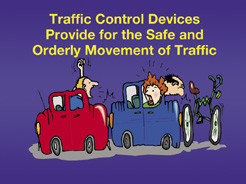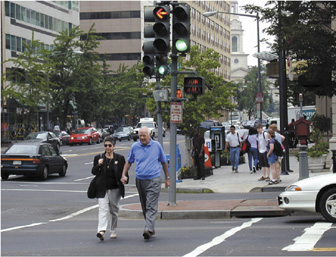| Skip
to content |
|
|
|
Manual on Uniform Traffic Control DevicesThis publication is an archived publication and may contain dated technical, contact, and link information.Traffic Control ChallengesTraffic control devices communicate important messages that are critical to transportation safety and efficiency. They provide for the orderly movement of all road users on streets, highways, and bike paths throughout our nation. Have you ever considered what it would be like to travel on roads not operated by traffic control devices? Traffic control devices such as signs, signals, and pavement markings not only methodically guide road users to their destinations and decrease potential congestion, but they also reduce the severity and number of roadway crashes.  The Manual on Uniform Traffic Devices (MUTCD) is the national standard for the design, application, and placement of traffic control devices. Its main purpose is to provide uniformity and consistency so road users know what to expect no matter where their travels take them. Uniformity also helps reduce the cost of traffic control devices through standardization, and it assists with the commercial movement of goods. New traffic patterns, unique roadway features, driver behavior, vehicle design innovations, and advances in technology all make it necessary to update the MUTCD on a periodic basis. The latest edition of the MUTCD was released in November 2003. The Federal Highway Administration (FHWA) recognizes that comprehensive analysis and careful consideration is required before changes are adopted in the MUTCD. What We're DoingThe Millennium Edition of the manual published in December 2000 was the first complete rewrite of the MUTCD since 1988. It was also the first time that an electronic version of the MUTCD was made available on the Internet (http://mutcd.fhwa.dot.gov). Some features of the MUTCD Web site include:
The most recent edition of the MUTCD has a new interim process for approving the use of new traffic control devices that are pending official rulemaking. Interim approval can be considered based on successful research or experimentation results. Once an interim approval is granted to one jurisdiction, other jurisdictions can be granted interim approval by simply submitting a letter of request to FHWA Office of Transportation Operations. A program is also underway that has assembled a consortium of national, State, and local entities to work with FHWA and establish a systematic and timely procedure to select, test, and evaluate novel concepts and applications for traffic control devices. Future Directions for Traffic Control DevicesUrban Application of the MUTCDThere are some concerns that the MUTCD may not adequately address all the unique traffic control needs of the urban areas for constrained conditions on downtown business district streets, alleys, and residential neighborhood streets. Also, since many States are adopting laws to make the MUTCD applicable on private roads and parking lots such as those in shopping malls, FHWA is addressing issues of modifications in the MUTCD to accommodate those conditions. Older Driver NeedsThe United States is facing an evolution in transportation fueled by the growing population of senior citizen drivers. Those age 65 and older represent an ever-increasing proportion of the overall population - from 1 in 8 (35 million older Americans) in 2002 to 1 in 5 (70 million older Americans) by 2030. Fatalities of older road users are increasing. Today's figures show that older adults represent about 13 percent of the population but account for 16 percent of all traffic deaths. FHWA has a key role to help improve the nation's transportation system so our older population can safely travel and maintain productive and independent lifestyles well into their senior years. The MUTCD team has developed a Pocket Guide that explains the MUTCD design and application principles that relate to FHWA's Highway Design Handbook for Older Drivers and Pedestrians (RD-01-103). The following areas are covered in the Pocket Guide to address older driver needs: 
Accommodating Persons with DisabilitiesIn June 2002, the U.S. Access Board released draft guidelines on accessible public right-of-way and made them available for public comment. The guidelines address access to public streets and sidewalks, crosswalks, curb ramps, street furnishings, parking, and other components of public rights-of-way for persons with disabilities. The Access Board plans to publish a notice of proposed rulemaking in 2004. Areas of the MUTCD that could be affected are traffic roundabouts, criteria for accessible pedestrian signals and crosswalks, and accommodating persons with disabilities in construction zones. Expanded Application of Changeable Message SignsToday's information age and technology advances have raised the level of expectation of our road users and created much more savvy drivers. Road users have come to expect real-time information from both the vehicle and the roadway. The use of changeable message signs for traffic control can be tremendously helpful for providing real-time regulatory, warning, and guidance information. A project is underway to develop proposed language in the MUTCD to address the variety of uses for changeable message signs that will be included in a future proposed rulemaking. In summary, the MUTCD goal for the 21st century is to reduce traffic congestion and improve the day-to-day operations of our transportation system through better roadway communications that use traffic control devices and incorporate technology advances. Our approach is customer focused and based on a partnering philosophy that relies on input from organizations and individuals that have knowledge and experience in manufacturing, installing, selecting, and maintaining traffic control devices. For more information about the MUTCD, visit https://mutcd.fhwa.dot.gov/ For more information on FHWA Office of Operations activities, visit our web site at https://www.fhwa.dot.gov/operations April 2004 FHWA-OP-04-049
|
|
United States Department of Transportation - Federal Highway Administration |
||